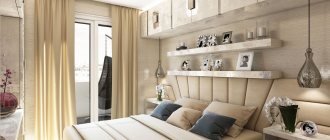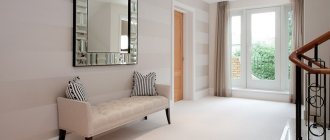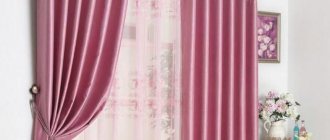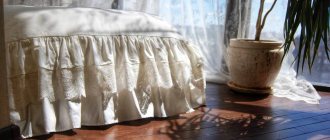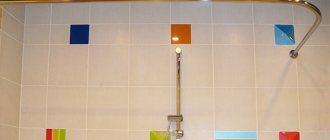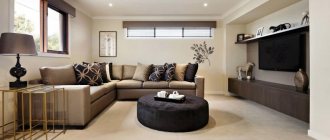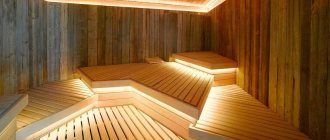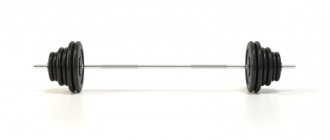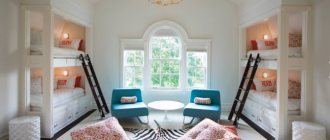Felix
6690 0 0
Felix September 25, 2018Specialization: philological education. 20 years of experience as a builder. Of these, for the last 15 years he led a team as a foreman. I know everything about construction - from design and zero cycle to interior design. Hobbies: Vocals, psychology, quail breeding.
The drawer connects the elements of the bed.
Greetings, my dear readers.
When making furniture, each element of its body has its own meaning. The drawer, which is little known among ordinary users, also plays an important role. What kind of element is this, what is it for, what types of furniture is it present in, what are its characteristics? Let's figure it all out.
The drawer drawer is an important element of any furniture
Furniture production is a labor-intensive and responsible process in which the role of each structural element is important. One of them is the drawer, which is little known to most - this is the main element of furniture that contributes to the reliability of the table, chair, sofa and even stool. What is this element?
According to its design features, the drawer is a connecting part on which the reliability and strength of bolts and ties depends. In addition, it is a support for any furniture attribute. Let's look at a simple example: a chair consists of a table top and legs. But they are not attached to each other, but to a connecting board, which ensures that the legs do not wobble and stand stably, holding the tabletop. That is, the drawer is the simplest connecting element that holds the entire structure together.
Which pieces of furniture have drawers?
Any rectangular structure (be it a table, chair, stool) requires fastening the legs to the tabletop. For example, in a table and chair, the drawer is an important element, and there are four of them: one along the entire perimeter of the structure. The bed has three drawers, which are fastened together and with the head of the bed. Their main purpose is also that a mattress is placed on this frame. In some models of beds, the drawers may be upholstered with fabric or other material.
In sofas, the drawer is mounted under the seat, and it also fastens the armrests. As a rule, it is covered with the same fabric as the entire sofa. On average, the height of a sofa drawer reaches 30 cm with a maximum length of 190 cm (these indicators depend on the design features of each specific sofa). As for the material, chipboard, plywood or solid wood species can be used. In the chair, the drawer is also located under the seat and attached to the armrests, while its height has a maximum of 30 cm and a width of no more than 80 cm.
Interior doors: drawers are an important element
In this case, the drawer is a transverse crossbar with which the door leaf is connected. This element contributes to the strength and reliability of the door frame structure. At the same time, the drawer itself is made of laminated solid coniferous wood and MDF. The peculiarity of the door leaf is that it has a facing coating without joints and cracks, and the combination of coniferous timber and MDF ensures that the door will last much longer and more reliably.
We build it ourselves
Probably, many craftsmen are capable of making furniture with their own hands, for example, simple stools or tables for the garden. There is nothing complicated in the process, the main thing is to take care of every detail. For example, making a drawer with your own hands is very simple.
To create a stool you will need four of them. It is best to make these frames from hardwood - this way they will last much longer. The dimensions of the workpiece depend on the length and width of the stool. The frames need to be planed and milled if the bars need to be given a certain shape. The ends of the drawer can be cut at a certain angle - this depends on the design features of the stool. The products will be attached to the legs at a certain angle, which must be taken into account during assembly. After preparing all the components, you can begin gluing the structure.
Wooden bed "Titan" Estella
The Titan bed is the embodiment of power and primitive strength. A simple, even somewhat rough design, a low footboard, and geometric lines create a feeling of reliability and solidity. The massive, durable design will withstand high loads.
Particular attention should be paid to the specific tilt of the headboard, which allows you to sit comfortably when reading or watching TV. This model will fit perfectly into an interior designed in a minimalist style.
The bed is equipped with durable orthopedic slats and is available in 8 different shades of natural wood. The headboard can only be of standard height.
Natural wood - beech
The “Titan” bed is made of natural wood – beech. There are two types of material to choose from – solid and shield.
Glued board is a wood material obtained by gluing wooden blocks along the width and length. In no case is the shield made from wood waste; its difference from solid wood is only in appearance. Due to the fact that shorter bars are glued several in a row, a combination of different shades and structures can be obtained in one product. All other characteristics, such as reliability, wear resistance, coating quality, are absolutely identical to the array.
Solid wood is a wood material obtained by gluing only the width of long bars. Please note that solid wood is not a single piece of wood. The price of the array is slightly more expensive than that of the shield, this is only due to the peculiarities of the technological processing process.
What's better? Shield or array
The first thing you should pay attention to is that the Estella factory uses exclusively one type of wood in the production of both panels and solid wood - hard beech.
Shield
A shield is a material in which elements of different sizes are spliced and glued together. There is a myth that the shield is a product of industrial waste, this is not true. It is made from working wood using sophisticated processing technology.
The technological production process begins with the production of boards from round wood. A board is wood that has not been glued. This material is very vulnerable, sensitively reacts to changes in temperature and humidity, responding with the appearance of cracks and irregularities. It is impossible to make a piece of furniture from boards, with the exception of coniferous species. When processing boards, knots, damaged parts, and cores are cut off, after which slats of different lengths remain. From longer ones (from 1.5 m) an array is glued together. The rest are glued together into a shield.
Array
The array is very often mistaken for ordinary boards, however, this is not so. It is a solid-lamella material, the elements of which are glued together only along the length.
Both the shield and the array are reliable and have high performance properties. The difference between them is solely in appearance and price. Solid wood is more expensive due to the specifics of the woodworking technological process.
Jowat glue
In the production of both materials, high-quality German glue is used, which is a leading manufacturer of wood glue in Western Europe. The brand – D2, D3 or D4 – depends on the gluing area and the drying/pressing method.
Lamels
The Titan bed is equipped with slats made of beech plywood 8 mm thick. The slats are the slatted base of the bed on which the mattress is placed. Their special curved shape provides additional orthopedic effect and comfort. The length of the bed and the distance between the slats determine the number of slats per bed (see table on the right).
Colors
The Renata bed can be made in one of the shades presented below. Please note that when ordering furniture in white (shade 107), an additional payment of 25% of the product price is required.
The wood is painted in a complex, multi-stage technological process using high-quality and safe leading varnishes. You can be sure of excellent performance, high wear resistance, environmental friendliness, as well as impeccable appearance of the furniture.
Furniture drawer, what is it?
The word “tsarga” itself has German roots and comes from “zarge” - box, frame. Furniture manufacturers use this word to designate special connecting strips, horizontal stiffening ribs located between the load-bearing parts of the structure.
As a rule, for items related to cabinet furniture, the drawer has the form of a horizontal flat part, a panel panel connecting the vertical supports of the frame. For other products, this may be a block or lath, or several thin crossbars forming a plane.
A piece of furniture can have one or several drawers, depending on the design. They can be located around the perimeter of the product, forming a rectangular frame. Or placed at different heights, for example, at the bottom and top of the frame.
It is worth noting that drawers are used not only in furniture production. For example, various types of prefabricated interior doors are also often equipped with transverse panels - drawers.
How to transport a sofa correctly so as not to damage it?
How to transport a sofa is a problem that arises when moving, buying or selling a piece of furniture. This is a complex task that requires preparation, costs, and car rental. Successful organization, fast delivery cannot guarantee the safety of the cargo. Fragile, expensive furniture is damaged during improper transportation, there is a risk of theft and deterioration of the upholstery. But if you transport a sofa in a logistics company’s vehicle, you won’t have to worry about the safety of your property.
Features of disassembling a sofa for transportation
It is worth disassembling a sofa for transportation if its dimensions do not allow it to pass through a doorway without risks, there are many fragile elements, and decorative parts. Dismantled furniture is easier to pack, load, and move without involving many movers.
- Before disassembling the sofa for transportation, you need to study the mechanism and, depending on its type, dismantle the parts. “Book” - you need to lift the seat, lower it onto the back, unscrew the nuts, remove the armrests. The models have design features that should be taken into account when disassembling so as not to damage the integrity of the item.
- How sofas with many parts are transported - after disassembly, all elements are counted, packed in bags, and labeled. It is worth saving the manufacturer's diagram to quickly assemble the furniture.
- Packaging of large components - armrests, removable frames, seats - is insulated with bubble wrap, soft cloth to avoid puncturing the upholstery, scratches, chips. The mechanism is pulled together with twine to make it motionless.
To protect furniture from moisture and precipitation, you can cover the surface with film or tarpaulin.
Transportation of the sofa in one piece (assembled) form
The option of moving furniture without dismantling is convenient if the dimensions allow it to be carried through the doorway. No need to disassemble, invite a specialist.
- Measure the length and width of the object in advance to make sure that you can move the furniture down the staircase without risks. The most difficult thing to transport is corner models, with large protruding elements; it is difficult to maneuver and maintain the integrity of the upholstery.
- Ensure fixation - before loading into transport, Eurobooks, roll-out versions, models with lifting mechanisms are additionally secured with tape or rope to prevent them from unfolding on the way.
- Selection of transport - the logistics company analyzes the weight and dimensions of the object, and offers a vehicle with the required carrying capacity.
- Loading - riggers use lifting devices and ramps.
- Fastening in the body - it is necessary to fix it in a stationary position; belts, wooden restraints, and lathing are used.
When transporting a rare, expensive item, it is worth ordering a special case that minimizes the risk of damage along the way.
How to pack a sofa for transportation?
Dirt, moisture, shaking, accidental falls, shocks - when delivering furniture, you need to pay attention to packaging. Effective insulation of structural parts will reduce risks during travel, loading and unloading.
- Surfaces with soft upholstery, leather - special covers with tightening straps. For insulation, bubble wrap, thick fabric, and large blankets are used.
- Corners - you can cover them with sheets of cardboard and tighten the wrapping material with tape.
- It is advisable to dismantle the legs, but this is not possible - insulate them with fabric, foam rubber, cardboard.
- Decorative elements, removable mirror surfaces - pack separately in cardboard boxes, fill the voids with fabric, paper, tighten the box tightly with tape.
Transporting a sofa of any model is a complex undertaking; it is better to entrust it to a company that guarantees safety during the journey and is ready to compensate for losses.
Why do you need a furniture drawer?
Like other types of stiffeners, the drawer is used to give the product additional strength and stability. Imagine, for example, that an ordinary desk made of laminated chipboard panels consists only of sides and a table top. Such a structure will inevitably wobble and very quickly simply fall apart, since the connecting fittings will not withstand constant vibrations. The front panel (and in this case it plays the role of a drawer) connects the sides of the desk, fixes them in a vertical position, and gives rigidity to the structure.
The transverse ligaments between the legs of chairs or stools act in the same way. The drawbars connect the supports and prevent them from moving apart under the weight of seated people. They also make the product durable.
In addition to its main function, the drawer often plays the role of a decorative element. The front panel of the same desks can be richly decorated with various decorative elements. For example, shaped overlays made of MDF and solid wood, leather inserts, metal moldings, etc. In addition, the low-set drawbar covers the legs of the person sitting at the table, providing a more comfortable seating position.
In addition, the drawer is used to hide various technical details that have no aesthetic value. In particular, fasteners or the undecorated back of materials. And finally, the drawer often gives the product integrity and completeness.
If we talk about materials, drawers for cabinet furniture are most often made from laminated chipboards, less often from MDF. In addition, in various types of products, solid wood, plywood and even metal can be used as material for drawers. For example, there are a series of school desks with front panels made of perforated metal sheets.
Drawer for a moonshine still: what is it for, principle of operation
The process of moonshine brewing is simple from a technological point of view. The quality of the final product depends on the performance of the apparatus in which the process takes place. To improve them, additional modules will be needed. One of them is a drawer for a moonshine still.
What is a tsarga?
The difference between moonshine and fusel is the degree of purification. If the mash is poorly cleaned, the resulting product contains fusel oils. These impurities give the drink an unpleasant smell, taste, and also give the consumer a headache in the morning.
Drawer drawer for moonshine still
The tsarga removes fusel oils from alcohol vapors. Any experienced distiller knows what a drawer is in a moonshine still. This device helps make the final product several times purer after the first distillation.
Installation required
Why do you need a drawer in a moonshine still for home brewing? Every moonshiner who distills for himself at home understands that the purity of the product is the key to quality. A rectification chamber on an industrial scale helps to obtain raw alcohol, but for home you can use a simpler device.
In addition to cleaning, the drawer imparts strength to the final product. At the end you will get a drink several degrees stronger than classic moonshine.
Operating principle of the drawer
The principle of operation of the drawer of a moonshine still is similar to that of a steamer. Both devices operate by condensing vapors with different boiling points. The drawer works according to the following scheme:
- The steam turns into condensate and drains from the module head.
- The vapors move towards the condensate. The speed directly depends on the length of the device. The longer, the better the cleaning.
- The condensate feeds the vapors.
Since heat exchange is constant, the cleaning process does not stop.
Functions and structural features of the column
The tsarga also has another name - a strengthening column. But there is a big difference because it has filler. In fact, the tsar itself is a column that is installed above the distillation cube. The filler can be a spiral of copper wire or a simple stainless steel sponge. The last option is preferable.
The result is a fully-fledged filter that will help bring the strength of the drink to 60°, as well as clean it efficiently.
Like any filter, the drawer is removed and cleaned from time to time. Otherwise, the end result will be a tasteless drink with a pungent odor.
How does a column work?
The drawer comes in lengths of 15, 35 and 45 centimeters. Accordingly, it cleanses differently. Degree of purification - 20, 50, 60-fold. It is allowed to use several drawers on one moonshine still, which will further enhance the cleansing effect.
During cleaning, the condensed liquid goes back into the cube, and purified alcohol enters the refrigerator. In any case, the use of a drawer at the outlet gives a product several times stronger and purer than just a moonshine still.
Is it possible to replace it with a steamer?
Technically, of course, it is possible. But from the point of view of the final product, it is not worth doing this. The tsarga is several times more effective. The maximum degree of cleaning with a steamer is 20%, and with a drawer - 60.
Despite the fact that the principle of operation is similar, the drawer is much more efficient and allows you to obtain a higher degree of purification and strength of moonshine. Making a dry steamer with your own hands will not be cheaper. And if you can’t see the difference in price, then why neglect quality.
Therefore, experts say that you should not replace the drawer with a steam chamber.
Is it necessary to insulate?
Insulation is a controversial issue. Each distiller decides for himself how necessary this is. There are supporters of insulation who claim that this increases productivity. But many, on the contrary, argue that the modules must be cooled and even create special drafts near the device. Therefore, insulation is an individual matter for each distiller. You can insulate both the drawer and the distillation cube.
Drawbar for a moonshine still with a diopter
How to do it yourself?
For home brewing, you can make a tsarga with your own hands. No complex technical skills are required. You can create a collapsible module from several parts. A do-it-yourself drawer for a moonshine still will cost much less than buying a ready-made module.
Moreover, the quality of the homemade product will be even higher than the technical part. Anyone who has basic knowledge and skills can create a module. Of course, it is ideal if a person knows how to use a lathe, since it is difficult to cut threads on stainless steel by hand.
The assembly algorithm is as follows:
- We attach a conductor to the top of the pipe.
- We turn the pipe over and place it at the bottom of the other conductor.
- We attach the distiller to the top.
- Measure 3.5 cm from the bottom, then drill a hole in the pipe.
- Install the probe from a digital thermometer.
- We place stainless steel sponges into the pipe and attach a sieve at the bottom.
That's it, the homemade module is ready, start making an alcoholic drink that is safe for health.
Necessary materials
To make this module yourself, you will need:
- Pipe. The best option is stainless steel. This material is resistant to alcohol, oils and other substances. The pipe should be 35–45 cm.
- Conductor for attaching to the limiter.
- Sieve.
- 30 regular household washcloths.
- Elastic band from a medical dropper.
A set of materials is inexpensive, and therefore the final cost of a homemade module will please you.
What pieces of furniture have a drawer?
As we have already found out, the drawer is an indispensable attribute of tables on a panel frame. For classic desks, the front panel plays the role of the drawer. And, for example, in models for negotiations, such a detail is located in the middle part of the structure - to make it more convenient to sit on both sides without resting your feet on it. The drawer not only connects the sides of the table, adding rigidity to the structure, but also prevents the tabletop from sagging.
Other types of tables, such as dining tables, are also often equipped with this useful part. In this case, the drawers are usually located under the tabletop between the supports in the form of a frame of rectangular panels. A particularly important role is played by such strapping if the table is equipped with a sliding mechanism. After all, additional load from moving elements falls on the frame.
Most tables, chairs and stools that have four legs and are made using solid wood, plywood, chipboard, MDF or other wood materials are, in one way or another, equipped with drawers around the entire perimeter of the product.
Another piece of furniture that cannot do without such an important fastening element is a bed. Depending on the device, the beds have two or four drawers located around the perimeter of the structure. Sometimes, instead of drawers, the role of stiffening elements is played by the headboard and footboard of the bed.
Most sofas also have a rigid support frame equipped with one or more drawers. This design provides rigidity and strength to the structure, connecting the armrests or sides of the sofa. Like other elements of the frame, the sofa drawer is covered with upholstery material.
Kitchen furniture elements also have drawers. Floor cabinets or, less commonly, wall cabinets are also equipped with special strips that provide a more rigid connection of the sidewalls. They can be located both at the back and at the front of the cabinets. For example, under the countertop.
In principle, any furniture products that have a conventionally rectangular external or internal frame can be provided with additional stiffening ribs - drawers. For example, in cabinets - for a stronger connection of the sidewalls. Drawer frames in cabinets, tables or cabinets also have side drawers.
Finally
A furniture drawer is a useful item. After all, it provides our tables, cabinets, stools and beds with the necessary level of strength and reliability. Well, as a bonus, it can decorate the product and even make it more convenient to use.
Soft beds: luxury or benefit?
Is the presence of a soft bed in the house a sign of wealth, or does this fact emphasize the practicality of the owners? The question is not at all rhetorical. Soft beds have long been transformed from a luxury item into affordable furniture that can be found in many apartments.
The price of such beds is quite equal to the cost of their “all-wooden counterparts,” and the production itself has made great strides forward. And now many modern upholstery materials are available to customers - inexpensive, practical and durable.
But let’s look in more detail at what characteristics soft beds are not inferior to, and sometimes greatly superior to, the wooden structures we are accustomed to.
The expression “you meet someone by their clothes” largely applies to the situation with buying a bed: perhaps the first and almost the main factor that people pay attention to is the beautiful and aesthetic appearance of a piece of furniture.
In no case do we undertake to say that soft beds look better than wooden ones, or vice versa. It's all a matter of personal preference. But, at the same time, the peculiarities of the production of soft beds provide much more opportunities for design experiments.
Judge for yourself, how many different color schemes of wooden and laminate beds have you seen with your own eyes, even in catalogues, and can you name them offhand? 5? 10? Definitely no more. And with textures in general everything is “sad”.
At the same time, in the production of soft beds, various upholstery materials are used (leather, eco-leather, fabrics), which can have a variety of colors and textures.
Even without deep knowledge of mathematics, you can understand that the number of variations is growing exponentially. And this is not counting the fact that different materials and colors can be combined in one product. In general, you can find a suitable option for any interior.
We've sorted out the color and texture, let's move on to the form. Wood, as you might guess, is not very plastic, and sophisticated experiments with shape and design in the mass production of beds are not rational, as they require too many resources. Of course, if you have enough finance, you can make a custom-made wooden bed that will meet all your whims.
But, alas, not each of us can boast of such a level of income.
It’s a matter of soft beds: through the use of different materials and decor, even the simplest and most modest forms begin to play with new colors. There are rounded corners, straight corners, and any shape in general. Do you want strict geometry? Please. Or maybe you want something romantic and abstract? Of course! Thanks to different combinations of materials and textures, even one model can match different bedroom interior styles.
What is a bed frame, what is it intended for and what can it be?
The drawer connects the elements of the bed.
Greetings, my dear readers.
When making furniture, each element of its body has its own meaning. The drawer, which is little known among ordinary users, also plays an important role. What kind of element is this, what is it for, what types of furniture is it present in, what are its characteristics? Let's figure it all out.
In which furniture elements is
What is a drawer in furniture? Any rectangular product has a connecting part in its design, located between the tabletop and legs. In such furniture as a table or chair, it is a more important element and is installed around the entire perimeter. A bed, for example, includes only three such elements, installed at the head of the bed, also fastened together. In this case, they have another purpose, which is to hold the mattress. Almost all manufacturers upholster the drawer with various materials. On a sofa, this part is installed at the bottom of the product and connects the elbows to each other, after which it is upholstered with fabric (A collection of different and interacting tissues form organs)
.
What is a tsarga?
Most of the cabinet furniture parts have fairly simple names. Using these terms, it is possible to quickly understand which particular structural element we are talking about.
Item characteristics
But among the furniture parts there are some whose names mean little to non-specialists. Among them is the king. The term comes from the German word “Zarge”, which translates as “frame”.
This is the same king.
The drawer is a horizontal connecting strip. It is placed between the legs of a bed, sofa, chair, table and other pieces of furniture. The bar strengthens the body and gives it sufficient rigidity. This happens due to the additional fixation of the product elements with its ends.
- Furniture equipped with four or more legs (tables, chairs, etc.) . In this case, the drawer is a frame made of boards or bars that rigidly connects these supports.
- Beds, sofas, doors . In these designs, the drawers are horizontally oriented cross members. They provide connection between the vertical posts and each other. That is, these are the upper or lower horizontally oriented frame trims.
In panel interior items, the drawer is a wide panel.
- Panel furniture . Connecting strips are also used in its manufacture. They perform their traditional function - they impart rigidity to the structure.
However, these elements look a little different. Most often, they are a wide and heavy panel. These details play an aesthetic role, often a central one. In addition, such details cover the fixing and other technical elements of the object.
Pasteurization drawer for selecting “heads” during rectification
Even such a powerful tool as a distillation column does not allow one to isolate a separate impurity and remove it from the column independently of others. In practice, substances need to be grouped, but the boundaries between these groups are blurred. A special unit of the distillation column - the pasteurization chamber (CP) - helps to solve the problem of removing the last drops of head impurities.
Theory. When selecting the head fraction, we let the column work for itself and accumulate the head impurities at the top of the column, then we begin their selection for some time at a rate no greater than the speed at which these impurities are removed from the cube into the column. The higher the concentration of these substances in the cube, the more of them enter the column per unit time. This determines that the concentration of impurities in the head fraction is maximum in the first hour of selection, in the second hour it drops by approximately half, and in the third - by another half.
If initially a substance contained approximately 2000 mg/l, then after 10 hours of sampling the “heads” it will become approximately 2 mg/liter. If the impurity was 2 times less, then the required 2 mg/l will be obtained after 9 hours, and if it is 2 times more, then after 11 hours. The time for selecting “heads” depends little on their initial concentration.
High-quality removal of the head fraction requires a lot of time. But even after selecting the “head”, a lot of impurities remain in the column, smeared throughout the entire height. Therefore, we select the headrests, washing the nozzle from their remains.
After this, it seems like you can breathe easy and start taking away the “body”. But if you strive to obtain truly pure alcohol, you will have to pay attention to the fact that the cube contains many different substances, which, when boiled for a long time, form new head impurities. In addition, in the reflux condenser at the interface of alcohol vapor and air, oxidation occurs and new aldehydes are formed. Well, if you didn’t have enough patience for the 7-8 hour selection of the head fraction, then their remains will continue to flow into the column during the selection of the “body”.
All these factors add up and produce a noticeable negative result. To combat the last drops of head impurities, pasteurization tanks are successfully used.
Do-it-yourself assembly
You can make simple pieces of furniture yourself.
Often, users undertake to make simple pieces of furniture themselves, for example, a stool, table or chair. After all, there are no complex elements in their design, and the work is not very labor-intensive.
Here you need to take into account that all furniture elements must be made correctly:
- To make a simple stool or chair, you need to prepare four connecting slats.
- If you choose a solid type of wood for this, the piece of furniture will last a long time.
Before assembling a piece of furniture, it is necessary to accurately determine the dimensions of all its elements.
- The dimensions of each element depend on the expected size of the stool, table or chair. Based on this, it is extremely important to determine in advance what the length and width of the interior item will be.
- Corner strips for furniture legs must be cut at an angle, based on its specific design features. This should be taken into account when assembling the item. In addition, it is important to consider at what angle its supports will be fixed.
The best material for furniture is natural wood.
- It is necessary not only to do the job correctly, but also to correctly select the material for assembling the furniture, as well as the elements of the lifting mechanism (if provided).
When you select furniture in a showroom or place an order for its assembly, take a closer look at the quality of execution of its individual parts. The reliability, strength, comfort and service life of a household item depend on this.
Name of furniture parts
After reading this text, you will easily understand the instructions for assembling furniture. Moreover, a picture of the assembly diagram will immediately form in your imagination. This will increase your productivity several times and minimize the risk of errors.
But, before listing the list, let's look at the name of the cabinet furniture modules. Remember that the section that hangs on the wall is called a cabinet. The section that stands on the floor is called a cabinet. Drawers in furniture are only retractable.
What is a tsarga
This value assumes a structural component of almost every existing furniture. With its help, the legs and the main part of the device are connected. In addition, the presented element serves as a support. Its fastening can be done in various ways. The list includes various ties, bolts, and tenon joints.
To make sure you understand the full significance of the product, you can give a simple example. Let's say the master will attach the supporting component directly to the tabletop. Thus, two products will not ensure reliability in the structure, but, on the contrary, instability. To prevent this, there is a frame described that allows the connection to be made properly.
Main difficulties
The most common problem is the loosening of the fasteners on the frame for the bed, which is installed at the headboard (the mattress is held on it). It's not difficult to fix the problem - just tighten the loose screws.
You can do it differently by strengthening the system with corners. This method is used in cases where the screws have significantly destroyed the wood and cannot be tightened. The advantages of corners are that they have several holes on each side: this increases the chances of securely fastening parts to entire areas.
The situation is worse when the frames for the bed are broken. They can be made independently if you have carpentry skills and the right tools. If there is neither one nor the other, you will have to contact a specialized workshop.
Bed drawer - element characteristics
Speaking about the qualities inherent in a piece, it is important to emphasize that they are different for each piece of furniture. Therefore, let's look at each aspect in detail:
- For beds, sofas and similar devices, the drawer ensures that the vertical posts interact with each other. Thus, the structure can be represented in the form of crossbars that are oriented in a horizontal position.
- In products consisting of four or more legs, for example, chairs, tables, the component is represented in a different image. That is, we can say that this is a frame made of boards or wooden beams. It provides maximum strength and creates support.
- In panel furniture, this is most often a panel, and a large and heavy one at that.
- For doors. This increases strength and ease of installation. In addition, seams at the joints of parts are eliminated.
As for the material from which it is created, this is a list of the following varieties:
- Natural wood.
- Metal, it can be steel, bronze, brass.
- MDF.
- Laminated chipboard, veneered or painted boards.
- Plywood, and it should be thick.
IMPORTANT! When used for upholstered furniture, this product is wrapped in thick fabric or leather to prevent possible damage. Thus, we can talk about the variety of source materials from which drawers can be prepared, as well as their widespread use in various furniture structures.
Where did the title come from?
In fact, this is a tracing paper from the German “zarge”, which literally translates as “frame”. The drawer is a horizontal bar that connects the legs of a sofa, chair or other pieces of furniture. Main functions: strengthening the frame, ensuring the reliability of fasteners, supporting the mattress and guaranteeing convenient use of the product.
If we are talking about beds, then the drawers connect the headboard and footboard. Their main task is to give the skeleton the necessary hardness and stability, and to firmly fix other structural elements.
DIY production
Most craftsmen, without the help of others, take on the production of such ordinary pieces of furniture as stools or even tables, the system of which is nothing complicated or labor-intensive. The only important thing is to keep in mind that any element must be done correctly. To make a stool, you will need to create 4 drawers.
Advice!
If you use hard wood during production, you can achieve the longest service life of the product.
The size of each part depends on the expected size of the product itself, so it is very important to know what length and width your stool will be.
